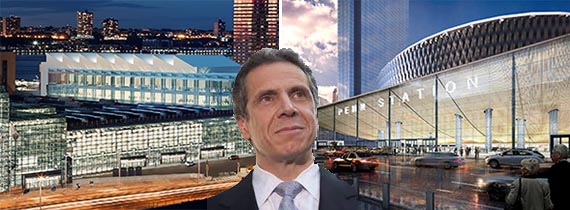Trending
Here’s how Cuomo is trying to hasten Penn Station’s redevelopment
Critics warn certain state agencies aren't ready for design-build method

A tool that, by some estimations, has dramatically sped up the construction of the new Tappan Zee Bridge could give the same boost to the beleaguered Penn Station and Farley Post Office redevelopment, but some question whether the state is ready — or able — to wield it.
In his proposed executive budget, Gov. Andrew Cuomo outlined his interest in allowing the Empire State Development Corporation to use design-build, a project delivery system in which the owner of a project signs one contract with a single party — usually a construction company — that handles both the design and construction of the project. The method is often touted as a money and time saver, since it streamlines the procurement process and limits design conflicts. Critics argue that design-build stifles competition, since only a select few companies are equipped to carry it out.
If permitted, ESD could apply the method to the $1 billion overhaul of the Javits Center and the $3 billion redevelopment of Penn Station and the Farley Post Office, the latter of which has faced delays for myriad reasons since the 1990s.
But in his review of the budget, state Comptroller Thomas DiNapoli argued that not enough is known about how this method will impact the projects. Greater protections, such as cost-benefit analyses and financing plans, are needed before extending design-build authority to ESD, he said.
While the method “may provide opportunities for budget savings and construction efficiency, greater transparency and accountability should also be required to ensure that the use of these alternative procurement methods is justified,” DiNapoli stated in his report.
The parameters of design-build authority have been on the table for some time. New York is one of five states with the strictest limitations on design-build, allowing its use only at the following agencies: the Department of Transportation, the Department of Environmental Conservation, the state Thruway Authority, the state Bridge Authority and the Office of Parks, Recreation and Historic Preservation.
In January 2014, Cuomo recommended that the practice be expanded to other state agencies. In March, lawmakers opted to instead extend the practice through March 2017 — but only for those five agencies. In June, the ESD is expected to release a report on the use of design-build as it currently exists, and DiNapoli said the state should wait to see the results of that report before expanding authority to more agencies.
“While design-build has been used in some instances, it is still the exception not the rule,” Robert Ward, the deputy comptroller, told The Real Deal Tuesday. “Contracting is inherently a complex and costly process. The state wants to make as sure as possible that things are done in a cost-effective manner.”
Representatives with ESD told TRD that the proposed legislation doesn’t require the use of design-build; it merely provides the option should they decide it is the best approach. Since ESD has already hired an architect, Skidmore, Owings and Merrill, to design Moynihan Station, developers will have the option to either use SOM’s designs and use design-build for the rest of the Empire Station Complex or use the designs for guidance and complete the whole redevelopment using design-build.
Terrence Oved, a real estate attorney at Oved & Oved, said that proponents of the delivery method would argue that design-build is ideal for Penn Station and Javits. At the same time, the state’s experience with the system is largely limited to bridges and other infrastructure.
“It hasn’t been used so much in New York to create structures,” Oved said. “It’s a very interesting question whether these skills translate.”
Still, the prospect of saving on cost and time is particularly alluring for projects that have remained in limbo for years. The redevelopment of the Farley Post Office and Penn Station has been more than two decades in the making, only recently jump-started by Cuomo with the issuance of an RFP. The Tappan Zee Bridge, whose replacement has been talked about for 30 years, is often held up as a prime example of design-build’s ability to speed up a languishing public project. The project’s schedule, according to a report by the New York University’s Rudin Center for Transportation, ended up 18 months shorter and an estimated 15 percent cheaper than it would have been under the design-bid-build model.
Richard Thomas, director of state and local legislative affairs at the Design-Build Institute of America, an advocacy group for the practice, said that design-build typically speeds up projects by 33 percent. It ensures the designer and contractor work closely together and leads to fewer change orders during construction, he said. Unlike in traditional design-bid-build projects — where an owner hires an architect to design the project then finds a contractor to execute it — the design team works together from the start of the project. This relationship, Thomas said, shifts cost overruns to the design-build team, not the owner.
Pat DiFilippo, an executive at Turner Construction Company, which is part of a team bidding on the Penn Station redevelopment and has used design-build on up to 15 percent of its portfolio, said that there is a misconception that the method unilaterally shifts “universal responsibility” to the design team. It’s likely, he said, that both the train station and convention center will end up being design-build projects, as their size and complexity will demand a high level of collaboration. Design-build cuts time and costs and assures a higher quality, as long as the project’s owner is involved in the project upfront, he said.




